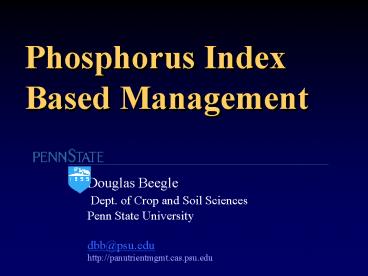Phosphorus in the Environment PowerPoint PPT Presentation
Title: Phosphorus in the Environment
1
Phosphorus Index Based Management
Douglas Beegle Dept. of Crop and Soil
Sciences Penn State University dbb_at_psu.edu http/
/panutrientmgmt.cas.psu.edu
2
Why do we need a P Index?Why not just agronomic
recommendations?
¼
Nutrient flows in modern ag
¾
?
P Index
Manure
P Index
Eutrophication
Regional P Balance
Field P Balance
3
P Index Critical Source Area Management
- Overlap of Source Transport Indicators
- Identify and manage the critical source areas
- Evaluate environmental risk
- Target effort and resources
Critical Source Area
Source
Transport
4
Critical Areas of P Export
90 of annual P export comes from 10 of land area
90 of P Loss comes from 10 of the watershed
Mahantango Creek Watershed, USDA-ARS
5
Managing Phosphorus Pollution
Transport
Sources
Runoff
Erosion
Leaching
Tile flow
Subsurface flow
Water Body
Hydrology
6
Soil Test vs P Loss
P loss, lb P2O5/A
P Threshold
Crop P Optimum
No recent P inputs
R20.80
Mehlich-3 soil P, mg/kg
Sharpley, USDA-ARS
7
Managing Phosphorus Pollution
Transport
Sources
Runoff
Erosion
Leaching
Tile flow
Subsurface flow
Water Body
Hydrology
8
Soil Test vs P Loss - with applied P
For all data points R20.40
P loss, lb P2O5/A
75 kg P/ha TSP 112 kg P/ha swine slurry 150 kg
P/ha poultry manure
Soil Only R20.80
Mehlich-3 soil P, mg/kg
Sharpley, USDA-ARS
9
Phosphorus Index
- P Source Site Characteristics
- Environmental Soil Test P
- Same soil test different interpretation
- Sampling Questions?
- P Saturation?
- P Fertilizer
- Rate and Appl. Method
- Organic P
- Rate and Appl. Method
- P Source Coefficient (PSC)
- Direct availability of manure P to runoff
- Based on WEP in manure
10
Managing Phosphorus Pollution
Transport
Sources
Runoff
Erosion
Leaching
Tile flow
Subsurface flow
Water Body
Hydrology
11
Phosphorus Transport by Erosion
12
Managing Phosphorus Pollution
Transport
Sources
Runoff
Erosion
Leaching
Tile flow
Subsurface flow
Water Body
Hydrology
13
Zone of Interaction with Runoff
- Location of applied P
- Interaction with runoff
- P on surface
- Soil test at surface
- High P Saturation at surface
- Psat P / Al FeOxalate extr. or Mehlich 3
extr.
14
Soluble P Transport in Runoff
1.0
Algal-available P, mg/L
Converted to no-till
0.5
0
Conventional till wheat
Sharpley, USDA-ARS
15
Managing Phosphorus Pollution
Transport
Sources
Runoff
Erosion
Leaching
Tile flow
Subsurface flow
Water Body
Hydrology
16
Soluble P Loss by Sub-surface flow
- Very Dependent on soil properties
- Hydrology
- Piston flow
- Macro pores
- Texture
- Soil Chemistry(Fe, Al, Ca)
- P loading/saturation
- Artificial Drainage
Data from Bolton et al., 1970 Culley and Bolton,
1983
17
P Loss is a Complex Landscape Process
Transport
Sources
Runoff
Erosion
Leaching
Tile flow
Subsurface flow
Water Body
Hydrology
18
Landscape Transport
Hydrology
Modified Connectivity Direct Connection
Modified Connectivity Riparian Buffer
19
Phosphorus Index
- P Transport Site Characteristics
- Soil Erosion
- Runoff Class
- Leaching Potential
- Sub-surface Drainage
- Contributing Distance
- Modified Connectivity
Drainage
Distance
20
PA Phosphorus Index v 2.0
21
P Index describes P loss potential
High
Very high
Medium
Low
P loss, kg/ha
75 kg P/ha TSP 112 kg P/ha swine slurry 150 kg
P/ha poultry manure
R20.79
P index value for the site
Sharpley, USDA-ARS
22
Phosphorus Index
- Low P Index
- N Based Management
- Medium P Index
- N Based Management
- High P Index
- P Based Crop removal
- Very High P Index
- No P Manure or Fertilizer
- High and Very High
- Modify Management based on P
- No or reduced manure
- Change time or method of application
- Conservation practices
- Buffers
- Etc.
23
Phosphorus Nutrient Management Plan
- Develop N based plan
- Usually means excess P will be applied
- Use P Index to evaluate the N based plan
- Is the risk of P loss acceptable
- Acceptable risk
- Apply _at_ N rate, excess P
- Unacceptable Risk
- Modify N based plan, where necessary, to address
P loss risk
or
or
NONE
24
P Index Application
- Eventually, all fields will have a high P index
- P Index is not the solution
- Tool to buy time to solve problem
- Minimizes negative impact of P while we come up
with a sustainable solution - We need to get the system into better balance
25
NRCS/EPA P Index Issues
- Proposed change in NRCS 590 Std.
- P soil test only No more P Index
- Easy to regulate
- Very strict limits
- Not supported by the science - Source/Transport
- Unrealistic for animal agriculture to comply with
in short term - Better soil P balance is a good long term goal
- Withdrawn, under further review
26
College of Agricultural Sciences
Department of Crop and Soil Sciences

